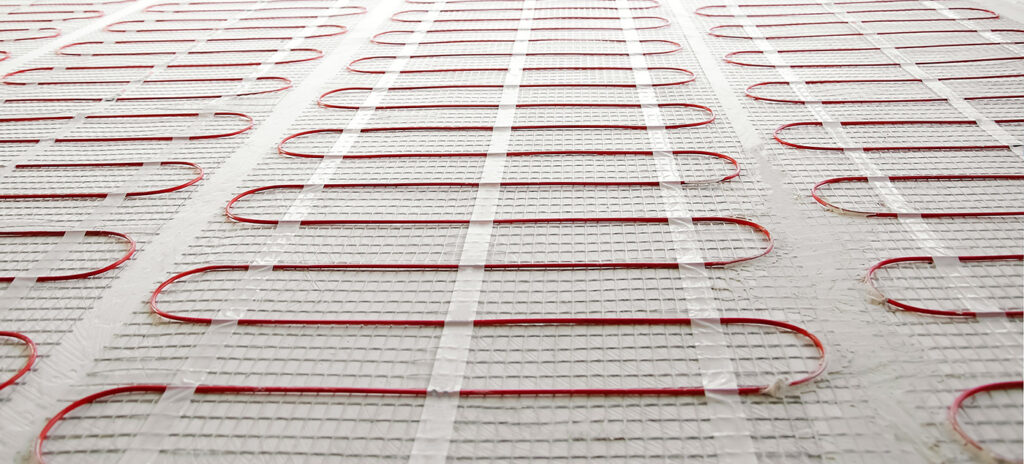
Choosing the Ideal Garage Heating Solution — A Close Look at Gas, IN-FLOOR Radiant, and Electric Options
Finding the ideal heating solution to keep your garage comfortable and inviting during chilly months can be a rewarding endeavor. Selecting the perfect heating system for your garage entails navigating through a myriad of options, ranging from forced-air (both gas and electric) to in-floor radiant heating (electric and hydronic). With such a diverse array of choices available, the challenge lies in determining which system best meets your specific needs, requirements, and budget.
To assist you with determining what are the optimal garage heating solutions, I will delve into each option with precision. In this article, I will guide you through the diverse array of Radiant In-Floor systems available for installation in your garage and tackle Forced Air options in our next article.
IN-FLOOR RADIANT HEATING
Exploring the Benefits of a Radiant Floor Heating Systems for Your Residential Home Garage
An alluring and efficient option well worth exploring is an in-floor radiant heating system. There are two types of radiant heating: Hydronic and Electric.

Hydronic (Liquid) RADIANT HEATING – Hydronic radiant heating systems utilize hot water flowing through pipes installed within the floor to distribute heat evenly throughout a space. Here’s how hydronic radiant heat typically works:
- Boiler or Water Heater: A central boiler or water heater heats water to the desired temperature. Typical heat sources for hydronic radiant heating systems include gas- or oil-fired boilers, electrical, wood-fired boilers, solar water heaters, or a hybrid combination of these options. Hydronic systems typically can be more expensive than electric radiant heat due to the need for a boiler or water heater.
- Piping Network: Pipes, usually made of PEX (cross-linked polyethylene) or similar materials, are installed within the floor embedded into the concrete slab.
- Heat Distribution: As hot water circulates through the pipes, it radiates heat upwards, warming the floor surface and the room above it.
- Thermostat Control: The system is controlled by a thermostat, allowing users to regulate the temperature to their comfort level.

ELECTRIC RADIANT HEATING – Electric radiant heating systems utilize electric resistance cables or mats installed beneath the floor surface to generate heat. Here’s how electric radiant heat typically works:
- Heating Elements: Electric cables or mats, typically made of materials like resistance wire or carbon film, are installed beneath the garage floor surface to produce heat.
- Electricity Supply: When electricity flows through these heating elements, they generate heat, warming the floor above them; whereas the hydronic liquid system differs in heating water in a boiler and circulating it through tubing beneath the floor to emit heat.
- Heat Distribution: Like hydronic systems, electric radiant heating radiates heat upwards, providing warmth to the room.
- Thermostat Control: The system is controlled by a thermostat, enabling users to adjust the temperature according to their preferences.
Electric systems tend to have simpler installation processes and may be more suitable for smaller areas or where access to a boiler or gas line is limited. However, liquid systems are often preferred for larger spaces or where energy costs are a concern, as they can be more energy-efficient over time.
Advantages of Radiant Heating
Efficient Heat Distribution – Since heat radiates from the entire floor surface, radiant heating systems provide uniform warmth throughout garage. Unlike conventional forced-air heating systems that rely on blowing heated air through vents, radiant systems evenly distribute heat, eliminating cold spots and ensuring a consistent, cozy temperature throughout the garage.
Quiet Operation – Radiant flooring systems are known for their quiet operation. Unlike noisy blowers and fans associated with forced-air systems, a radiant flooring system operates silently. This is particularly advantageous in a garage setting, where you might want a peaceful atmosphere for working, tinkering on projects, or simply enjoying your hobby without the distraction of a heater blowing in the background.
An Invisible Installation – Radiant systems are practically invisible, as the heating elements are hidden beneath the floor. This enhances the aesthetic appeal of your garage, allowing you to focus on the layout and design of the space without having to work around bulky heaters or vents. This not only maximizes the use of space but also eliminates the need for visible heating equipment, many of which are unsightly, that could interfere with your garage layout or aesthetics.
Energy Efficiency in their Operation – Radiant flooring systems are known for their energy efficiency. Hydronic heating systems, in particular, which takes advantage of water’s excellent heat conductivity (water conducts heat more effectively than air) allows for better retention and even distribution of heat, resulting in lower energy consumption compared to some other heating methods.
Reduced Air Circulation has Benefits – Traditional heating systems can stir up dust and allergens as they blow air through vents. In contrast, radiant heating systems do not rely on air circulation, reducing the potential for dust to be spread around the garage. This can be particularly beneficial if you use your garage as a workshop or storage space for sensitive items, like collector cars.
COST OF RADIANT GARAGE FLOORS
The cost of installing a radiant heating system for garage floors varies based on factors such as location, the size of your garage, installation type (hydronic or electric), floor covering (polished concrete, tile, floor coating or interlocking tiles), and local labor costs. Radiant heating system can potentially entail significant upfront costs due to initial equipment installation and complexities like zone valves and intricate piping and a more involved installation process compared to alternative methods.
Summary of In-Floor Radiant Heating Systems
Radiant flooring systems, whether hydronic or electric, offer unparalleled efficiency and tranquility for spaces like residential garages. Radiant floor heating transforms your garage into an aesthetically pleasing, comfortable, and inviting space by prioritizing consistent heat distribution and eliminating allergen circulation from air movement. This system embodies efficient energy utilization, even heat dispersion, and elevated comfort, making it ideal for those seeking optimal warmth and functionality in their garage.
The choice between the two depends on factors such as installation preferences, budget, and energy considerations. Before making a decision, it’s advisable to consult with heating experts who can assess your garage’s specific requirements and guide you toward the best heating solution for your needs.
[This article was written by Chad Haas, who has accumulated over two decades of experience designing and furnishing luxury garages all over the world. As the founder of VAULT and the only ASID Garage Designer in the world, Haas offers a unique insight into this specialized field.]